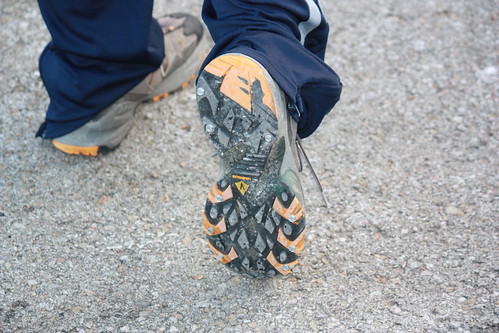
Time to lighten-up.
I haven't posted this for a while:
In the running and triathlete community the wearing of race T-Shirts has become a sign of accomplishment and fashion. Choosing just the right T-Shirt for that special occasion can be a daunting and difficult task. The following guidelines have been compiled (in fun), to help the responsible T-shirt wearer avoid potential embarrassment and/or elevate their perceived status in their athletic community. This list was formed from using various tri and runners' submissions, and then acquired, edited, exfoliated, and added to by me. You can send any suggestions of yours to me. If they are semi-coherent and not too offensive, I might add them. But then again, I might not.
Note: This is meant to be a tongue-in-cheek review of the sometimes superstitious regard runners and triathletes have for their finisher shirts. My personal view: I don't care if you wear your shirts wrapped around your head in an ever-expanding turban...so please, no nasty-grams back to me on back-channel e-mail. Have fun.
T-Shirt Etiquette Guidelines:
1. A shirt cannot be worn unless the wearer has participated in the event. There is an exception, though: "significant others" and volunteers are exempt.
2. Any race tee, less than a marathon distance, shouldn’t be worn to an ultramarathon event. This goes double for the wearing of sprint-tri shirts to Ironman and Half-Ironman events. It simply doesn’t represent a high enough "cool factor " and sends a red flag regarding your rookiness. It's like taking a knife to a gunfight. It's probably best just to wear a generic name-brand athletic shirt, and go hide in a corner until race time.
3. When you are returning to a race in which you have previously finished, then wear the shirt from the first year you completed the race. Don’t short-change yourself by wearing the shirt from the year before. It doesn’t adequately display the feat of accomplishment or the consummate veteran status that you are due.
4. Never wear a race event shirt for the (same) race you are about to do. Only rookies do this. It displays a total lack of integrity and might put the bad-heebee-jeebee-mojo on you for the race. Wearing a T-shirt of the race, while currently running said race, is discouraged. It’s like being at work and constantly announcing "I’m at work". Besides, you wont have the correct post-race shirt then...unless you like to wear sweaty, pitted-out clothes on a regular basis. If you do, then go back to the swamp, Gomer.
5. Never wear a shirt from a run that you did not finish. To wear a race shirt is to say "I finished it". Exceptions: see guideline #1.
6. A DNF’er may wear a race shirt if... the letters DNF are boldly written on the shirt in question (using a fat Sharpie or a Marks-A-Lot).
7. During a race, the wearing of shirt from a previously completed year is acceptable. Wear the oldest T-shirt you have from that race (see guideline #3). This is probably a good practice because you now have no excuse to drop out since you’ve done it before.
8. If possible, runners should buy significant others T-shirts which can be worn without regard to running the race. (see guide #1). Keep in mind, they support your "running Jones" more than you think. They also have ways of punishing you that you can't even imagine. Or maybe you can.
9. Volunteers have full T-shirt rights and all privileges pertaining thereto. So there. Remember, you can always volunteer for a race and get a shirt. I encourage this as your civil duty to be a member of the running community. Races don't happen without volunteers, folks.
10. No souvenir shirts: therefore, friends or anyone else not associated with the race may not wear a race shirt. If your mom thinks that your Boston shirt is lovely, tell her to QUALIFY for Boston herself, & send in her application early for next year, so she can earn her own shirt. A downside to this: she still has plenty of time to write you out of her will between her training runs for the big race. Note that your mom CAN wear your finisher's shirt under one of these 4 conditions- 1) you still live with your mother; 2) she funded your trip to the race; 3) she recently bailed you out of the slammer; or 4) All of the above. There is an exception to this guideline: (refer to # 1...If you are a "non-traditional family," and your mom actually is your Significant Other).
11. Always wear the race shirt of your last race at the current race’s pre-race briefing. The more recent the race, the better. This is a good conversation starter. However, avoid the tendency to explain how that it was a training run for this, and this is just a training run for the next, etc. It just sounds like your rationalizing mediocre performances. Sometimes it’s best to live in the here and now.
12. Your t-shirt should be kept clean, but dried blood stains are okay, especially if it is a trail race or a particularly tough event. If you're an ultrarunner, you can even leave in mud and grass stains, (and porcupine quills). Not washing-out the skunk scent is pushing the macho thing a bit too far, though.
13. Never wear a T-shirt that vastly out-classes the event you're running. It’s like taking a gun to a knife fight. Or like unleashing an atomic bomb among aboriginal natives. You get the idea.
14. Also: never wear a blatantly prestigious T-shirt downtown or at the mall among non-running ilk. People will just think you have a big head, which you do. You'll also get stupid questions, like, "how long was that marathon?" If it's a shirt to a 50 or 100-miler, they'll think it's a shirt for a cycling event or just think you're totally nuts, which (of course), you probably are.
15. Never, ever, borrow a race finisher's shirt from another runner to wear to an event that you didn't run. If you do, remember that in Dante's Inferno, he wrote about a special Hell for characters such as you; right between Tax Collectors and Lawyers.
16. The Bad Ben Guideline: All children or grandchildren of mine can wear hand-me-down race finisher's shirts for races that I've run in. When they are asked, "did you run in that 100-mile trail race?" They can proudly respond, "no, but my daddy (or grandad) did." If your progeny has put-up with you being an ultrarunner, they have said rights too. If you have completed an Ironman, your kids also have the same rights. They've put up with a lot of crap (or outright neglect) over the years, and deserve to wear them.

17. The Bryner Guideline: Never wear a shirt that has more sponsors listed on it than people that ran in the event. (Are you listening, race directors?) A shirt with too many sponsorship logos on it is just plain ugly. If you're a race director, and have scored that many sponsors, how about sharing the wealth? Just give me a call at 555-6565, and ask for "Bad Ben." By the way, you can let ANYONE wear this ugly shirt; non-finishers and distant relatives, alike. If you respect your friends, kids, spouse or mother, though, you won't let any of them wear it. It would serve well as bedding in your kid's gerbil cage.
18. Never wear a shirt that has any sponsors on it that you don't agree with. For instance, if you're a Vegan, you shouldn't wear a shirt that proudly advertises "Omaha Steaks" on it. If you wear this shirt, the "Karma Gremlins" will catch-up with you . I swear that's why I fell and broke my nose in my last 50-mile trail run, or why I had plantar fascitis for most of '99. I never should have ran in the 1998 "Fantastic 4-Miler." Why would they enlist a sponsor from an North Korean land-mine manufacturer, anyway?
19. The Spencer Guideline: If an event is cancelled at the last minute, but the event shirts were already given out, you can't wear the shirt unless you actually ran the race on that day. This means you will have to run your own unsupported event, through snow storms, hurricanes, or whatever lame excuse the Race Organizers came up with for cancelling said event. If you still want to wear the shirt, you have to mark it with a sharpie, "I didn't run this lousy event, and I'm all the better for it, thank you," across the front of it.
20. This next one is a big one, and has something to do with the need for more good taste and asthetics in this sometimes ugly world. Never wear a shirt that is so old, thin, and threadbare that you can see the color of your nipples or chest hair through it. This seems to be just a "guy thing," especially and old-codger-runner-guy thing. Here's the test guys: if you're too scared to machine-wash your 1978 Tab Ten-Miler shirt for fear of it wafting down the drain as meer subatomic particles, then it's probably too transparent to wear in public. If you can (still) remember your great performance at that particular day and you want to save it for posterity, PLEASE have it framed so that you can keep it on the wall of your den or your "I love me" room, and (at least) out of public view. Better yet, have it sewn into a quilt. You can then sit on your couch and read back-copies of Runner's World, cuddled up with your "runner's binky," with a glass of warm milk.
21. By the way, if you don't know what terms like DNF, volunteer, or Significant Other are, then you shouldn't wear any race shirt until you know what they mean, and you shouldn’t have any meaningful relationships, either. You should probably become a hermit and/or New Age "Tantric" runner, sitting at home in the lotus position performing virtual marathons in your mind, while sniffing used GU packets, incense, and patchouli.
T-shirts must be used sensitively. Worn responsibly, they can help expand one's consciousness and immerse you in a great conversation with your running brethren. Worn stupidly, they can cause fright, horror, vacant stares, sprained ankles, and general social unrest. Don't be a "T-shirt Terrorist." Follow proper T-shirt etiquette to do your part for world peace.
___________________________________________
Happy trails,
Bad Ben






